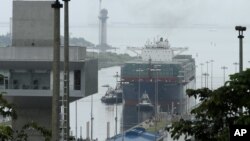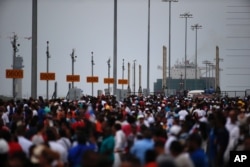Panama officially opened an addition to its fabled sea canal Sunday for a new generation of super cargo ships, capping a nine-year, $5.4 billion expansion project that will double shipping capacity and impact global trade routes.
Panamanian President Juan Carlos Varela unveiled the refurbished canal as the giant container ship Cosco Shipping Panama made its way through a string of locks on the 77-kilometer Isthmus of Panama. "This the route that unites the world," Varela told a crowd of about 30,000 people who gathered to witness the inaugural trip through the vital waterway.
Various foreign dignitaries, including the presidents of Taiwan, Chile and several Central American nations attended.
"There is evidence that the Panama Canal, with this expansion, is an important player not only for maritime commerce but worldwide," said Panama Canal Authority Executive Vice President Oscar Bazan. "[Clients] will benefit from not only saving time but also money because the canal is a route that shortens distance."
The latest generation of gigantic carriers -- more than 46 meters wide and 275 meters long -- could not fit through the 102-year-old canal.Unable to reach the U.S. East Coast by sea, many of the mega-carriers from Asia unloaded their goods in the ports of Los Angeles and Long Beach for shipment by rail to the rest of the country and beyond.
Many of the so-called "Neo-Panamax" ships able to navigate the canal will be stacked with containers nearly 15 stories high. Others will carry cargoes of grain, natural gas and other goods nearly three times larger than before.
Revenue boost
Analysts say the canal's annual cargo volume should double over the next decade, stoking hopes among Panamanian officials the tiny Central American country could triple the $1 billion in annual shipping fees it currently collects.
The revitalized canal has also spurred vast construction projects at ports on the U.S. East Coast and Gulf of Mexico.The ports of Miami, New York and Houston have deepened their harbors, expanded rail access and installed gigantic cranes to service the massive ships.
The Port Authority of New York and New Jersey will spend more than $1 billion to raise the height of the roadway on the bridge connecting Staten Island to Bayonne, New Jersey to accommodate the huge carriers.Leaving the clearance of the 85-year-old bridge at 46 meters would, according to economists, risk the eventual obsolescence of the Port of New York; North America's largest seaport.
Port of Miami director Juan Kuryla and U.S. Congresswoman Frederica Wilson are also expected in Panama Sunday for the inaugural transit. Wilson told the Miami Herald newspaper she expects the canal expansion and the $1.3 billion in local port improvements to accommodate the bigger ships will bring "thousands of high paying jobs" to south Florida.
Original canal
France began work on the original canal in 1881 before engineering problems and an increasing number of worker deaths from accidents and disease brought construction to a standstill.The United States took over the project in 1904, completing one of the most difficult engineering feats ever undertaken 10 years later.
The shortcut vastly reduced times and costs for sea travel between the Atlantic and Pacific oceans, with ships no longer required to round the southern-most tip of South America - the Strait of Magellan - to accomplish that goal.
Some material for this report came from AP and AFP.








